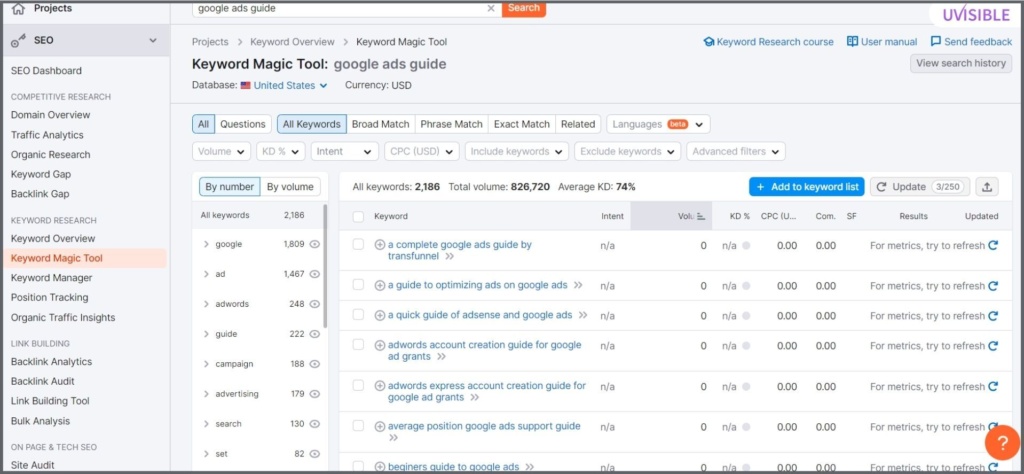Are high-volume keywords your primary focus, while zero volume keywords remain in the shadows?
The conventional approach to keyword research involves entering base keywords into tools like Google Keyword Planner, SEMrush, or Ahrefs.
Once you’ve gathered a list of keyword suggestions, the filters are set to identify relevant keywords with high search volumes.
But what if we told you that the real treasure lies in a seemingly empty mine of zero volume or low search volume keywords?
Before we delve into the world of zero volume keywords, let’s first explore the realm of high-volume keywords.
What are High Volume Keywords?

The quest for driving thousands and thousands of traffic to your website has given rise to blindly going after keywords with high search volumes.
High-volume keywords are terms that are searched for thousands and thousands of times in a month.
This keyword search volume is given by keyword research tools like Google Keyword Planner or SEMrush.
In the realm of Search Engine Optimization (SEO), keywords serve as the foundational building blocks of content.
They function as signals to search engine crawlers, indicating the relevance of the content to specific search queries.
Consider, for instance, when you enter a query such as “Brad Pitt Age” or “Angelina Jolie Upcoming Movies” into Google, and the search engine promptly furnishes you with pertinent results.
In this context, the query itself, such as “Brad Pitt Age,” is a keyword that publishers strategically employ to communicate to Google that their webpage contains relevant information about Brad Pitt’s age, addressing the user’s intent.
But what distinguishes a keyword as “high-search volume”?
The answer lies in the frequency with which users conduct searches using that keyword. It is determined by the sheer volume of daily or monthly searches performed on Google for that specific keyword.
In the day to day conversation, High Search Volume keywords are also called Short Tail Keywords.
Coming to Zero Search Volume Keywords

Why are Volume Zero or keywords with low search volume talked about so much these days?
It is crucial to clarify that “zero volume/low search volume keywords” do not imply keywords with absolutely no monthly searches.
Instead, it refers to those keywords that, while possessing search intent, escape the notice of traditional keyword research tools and databases.
A pertinent question arises:
What distinguishes zero search volume keywords from their low search volume counterparts?
The answer lies in their audience—individuals who exhibit a nuanced aptitude for keyword-based searches.
Furthermore, it’s important to note that zero-volume keywords share a connection with long-tail keywords, albeit not every zero search volume keywords is inherently long-tail, nor is every long-tail keyword bereft of search volume.
This paradigm shift in keyword strategy emphasizes thematic and intent-driven searches, prioritizing the intent volume over mere search volume.
The zero-volume keyword strategy is simple:
identify keywords that established tools erroneously categorize as zero-volume but, in truth, conceal latent intent.
These keywords can then be creatively reimagined in a variety of ways, effectively magnifying their potential.
As we venture forth in this exploration of keywords with low search volume or volume zero keywords, it’s worth acknowledging the insight offered by Mark Williams Cook in the 2022 podcast, who notably underscores the transformative potential of this approach in expanding the realm of intent volume.
In the following sections of this blog, we will meticulously dissect the theory and case studies surrounding zero-volume keywords.
Our mission is to unveil a novel and actionable perspective for digital marketers and content creators navigating the tumultuous seas of the digital information landscape.
Case Studies
Case Study 1: “Varsha Dongre Miss India Wikipedia”
| Keyword | Impressions | Clicks | Search Volume (On the Basis of Google Keyword Planner) |
| Varsha Dongre Miss India Wikipedia | 119 | 47 | 0-10 |
In this case, the keyword “Varsha Dongre Miss India Wikipedia” had a search volume range of 0-10, which is considered a zero-volume keyword.
Despite this, the keyword generated 119 impressions and 47 clicks, which indicates its success.
This suggests that the zero or low search volume keyword strategy was effective in driving traffic and engagement.
Case Study 2: “Varsha Dongre Wikipedia”

| Keyword | Impressions | Clicks | Search Volume (On the Basis of Google Keyword Planner) |
| Varsha Dongre Wikipedia | 22 | 10 | 0-10 |
In this case, the keyword “Varsha Dongre Wikipedia” also had a search volume range of 0-10. It generated 22 impressions and 10 clicks.
This demonstrates that even zero or keywords with low search volume can attract attention and traffic when incorporated strategically into the content.
Case Study 3: “Alanna Pandey Eye Color”

| Keyword | Impressions | Clicks | Search Volume (On the Basis of Google Keyword Planner) |
| Alanna Pandey Eye Color | 37 | 3 | 0-10 |
In this case, the keyword “Alanna Pandey Eye Color” with a zero search volume range generated 37 impressions and 3 clicks.
This case highlights how specific and detailed content around zero-volume keywords can attract a relevant audience.
Case Study 4: “Aaliyah Kashyap School”

| Keyword | Impressions | Clicks | Search Volume (On the Basis of Google Keyword Planner) |
| Aaliyah Kashyap School | 83 | 2 | 0-10 |
The keyword “Aaliyah Kashyap School” had a zero search volume range but generated 83 impressions and 2 clicks.
This demonstrates that catering to specific queries, even with low search volume or zero search volume, can still drive traffic to your content.
Case Study 5: “Stock Market Influencers on YouTube”

| Keyword | Impressions | Clicks | Search Volume (On the Basis of Google Keyword Planner) |
| Stock Market Influencers on YouTube | 54 | 2 | 0-10 |
In this case, the keyword “Stock Market Influencers on YouTube” generated 54 impressions and 2 clicks, despite having a zero search volume.
This demonstrates the potential of targeting niche, specific queries with a zero-volume keyword strategy.
Case Study 6: “Alanna Pandey Bio”

| Keyword | Impressions | Clicks | Search Volume (On the Basis of Google Keyword Planner) |
| Alanna Pandey Bio | 23 | 2 | 0-10 |
Even a specific keyword like “Alanna Pandey Bio” with zero search volume generated 23 impressions and 2 clicks.
This demonstrates that zero-volume keywords, when utilized effectively, can attract relevant traffic.
We hope that with all these case studies you have got the answer to the question, “What to do with Low Search Volume Keywords?” as in all these case studies, the success of the zero volume keyword strategy is evident.
Despite having no or very low search volume, these keywords attracted impressions and clicks, indicating that they fulfilled user intent and provided valuable content to a niche audience.
This showcases the effectiveness of creating content around zero search volume keywords, which can help digital marketers and content creators tap into untapped potential.
Step-by-Step to Zero-Volume Keywords for Maximum Traffic
In the digital age, understanding the art of finding keywords with low search volume can be the key to unlocking a treasure trove of untapped traffic potential.
While these keywords might not have high search volumes, they can be incredibly effective when used strategically.
Here’s a step-by-step guide to uncovering these hidden gems and harnessing their power.
Step 1: Define Your Content’s Purpose
Before you dive into keyword research, it’s essential to have a clear vision of your content’s purpose.
Creating content around zero or low search volume keywords should serve a specific intent.
Avoid keywords with absurdly low search intent, like, “10 Ways to Sit Creatively on a Chair” as they won’t likely drive meaningful traffic.
Instead, focus on addressing niche queries or providing unique insights.
Step 2: Identify High-Volume Topics

While zero search volume keywords will be your primary target, start by identifying high-volume topics related to your niche.


For instance, if you’re in the digital marketing space, “Google Ads Guide” might be a high-volume topic.
Even though ranking here is competitive, it can lead to the discovery of valuable zero-volume keywords.
Step 3: Utilize Keyword Research Tools

Quality professional SEO software tools like SEMrush, AHREFS, and Google Keyword Planner are invaluable in your quest for zero-volume keywords.
But don’t stop there; two additional gems in the world of keyword research are alsoasked.com and answerthepublic.com.
These tools offer a unique perspective by uncovering the questions and concerns of your target audience.
They add insight, validation, and creativity to your content strategy, making it easier to identify zero-volume keywords that cater to specific user intents.
The combination of traditional research tools and these innovative platforms can set you on a path to zero volume keyword success.
Step 4: Leverage Autocomplete Suggestions
Google’s autocomplete suggestions can be a goldmine for zero-volume keywords.
Try the “Alphabet Soup” method.
Begin with your main keyword and add each letter of the alphabet to reveal autocomplete responses.
This can unveil low search volume keywords related to your niche.
Step 5: Explore Related Searches

In your Google search results, scroll down to the “Related Searches” section.
These are often phrases and keywords linked to your main keyword, some of which might have zero search volume keyword data.
Take note of these, as they can provide valuable insights.
Step 6: Embrace the “People Also Ask” Section

The “People Also Ask” section in Google’s search results frequently includes volume zero keywords in the form of questions.
This is an excellent resource to find keyword variations that align with your content’s intent.
Step 7: Compile Your Zero Volume Keyword List
As you explore these various sources, compile a list of low search volume keywords that resonate with your content’s purpose.
Remember, the absence of search volume doesn’t necessarily mean a lack of user intent. These keywords often cater to a specific, motivated audience.
Step 8: Craft Your Content

Now that you have your keywords with a low search volume list, it’s time to create content that revolves around it.
Craft high-quality, informative, and engaging articles or blog posts that cater to the intent of these keywords.
Your content should provide value and relevance to the target audience.
Step 9: Optimize for SEO
Optimize your content for search engines.
Pay attention to on-page SEO elements like meta titles, meta descriptions, headings, and keyword placement.
This ensures that search engine crawlers can understand the relevance of your content to the chosen zero volume keywords.
Step 10: Monitor and Adjust
Once your content is live, monitor its performance.
Zero search volume keywords can surprise you with their ability to attract a niche but highly engaged audience.
Track your traffic, rankings, and user interactions. Adjust your strategy based on the results to continuously improve your content’s effectiveness.
Thus, the art of finding zero search volume keywords involves a strategic approach.
By focusing on specific intent, leveraging keyword research tools, and exploring Google’s features, you can uncover these hidden gems.
When used effectively, zero volume keywords can drive valuable traffic and set your content apart in a sea of information overload.
Embrace the untapped potential and watch your content thrive.
Why Should You Target Zero Search Volume Keywords?
In the world of SEO and content creation, targeting zero search volume keywords may seem counterintuitive at first.
After all, why invest time and effort in keywords that apparently have no search traffic?
Let’s delve into the reasons why incorporating zero-search volume keywords into your strategy can be a game-changer.
Beat Competition with Zero Search Volume Keywords
When you’re competing in highly saturated markets or niches, standing out can be a Herculean task.
This is where zero volume keywords come to your rescue. They offer a unique angle to beat the competition.
Example: Consider a broad high-volume keyword like “Digital Marketing Tips.”
You’re up against giants in the industry.
Instead, you could create content around a zero volume keyword like “Marketing Strategy for Hair Salon.”
While the latter might not have search volume, it precisely addresses a niche audience and reduces competition.
Ready to dominate your local market? Explore Uvisible’s affordable local SEO services and boost your online presence today.
Easy to Rank
Keywords with low search volume are not only less competitive but also easier to rank for.
With a targeted approach, you can secure top positions on search engine result pages (SERPs), even if the keywords don’t have substantial search volume.
Example: Imagine you’re targeting the low search volume keyword “Sustainable Gardening Practices in Arid Climates.”
This specific topic might not have many competitors, making it easier for your content to rank higher and reach an interested audience.
Better Traffic
Zero volume keywords may not attract massive traffic, but they do attract the right traffic.
These keywords often cater to users with a highly specific intent, resulting in more engaged and relevant visitors.
Example: Let’s say you’ve created content around the zero-volume keyword “Best DSLR Camera Settings for Astrophotography.”
While it might not have the same search volume as “DSLR Camera Settings,” those who find your content are likely passionate about astrophotography and more likely to stay on your site, engage with your content, and potentially convert.
In essence, zero-volume keywords allow you to break away from the crowd and tap into highly focused and motivated audiences.
They can be your secret weapon for niche marketing, ensuring that the traffic you receive is not just in quantity but in quality too.
By strategically using zero volume keywords, you can set yourself apart, rank higher, and connect with the audience that truly matters.
From Our Perspective!
Zero volume keywords are your secret weapon in the digital marketing arena.
They bring niche audiences, less competition, and higher rankings.
By strategically integrating these keywords, you unlock untapped potential and ensure valuable traffic.
Quality over quantity is the name of the game.
Embrace low search volume keywords, and watch your content flourish in a world where relevance and engagement take center stage.
In this digital age, this strategy sets you apart, guarantees engagement, and propels your success.
About us and this blog
We are a digital marketing company with a focus on helping our customers achieve great results across several key areas.
Request a free quote
We offer professional SEO services that help websites increase their organic search score drastically in order to compete for the highest rankings even when it comes to highly competitive keywords.
Subscribe to our newsletter!
More from our blog
See all postsRecent Posts
- 10 Holiday Marketing Tips: Boost Sales & Engagement December 21, 2024
- 10 Common Mistakes Roofing PPC Companies Should Avoid December 19, 2024
- Landing Page Copy That Converts – Secrets Revealed December 16, 2024








